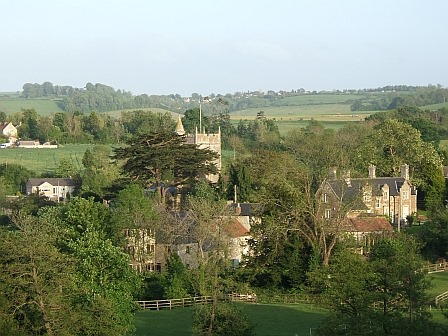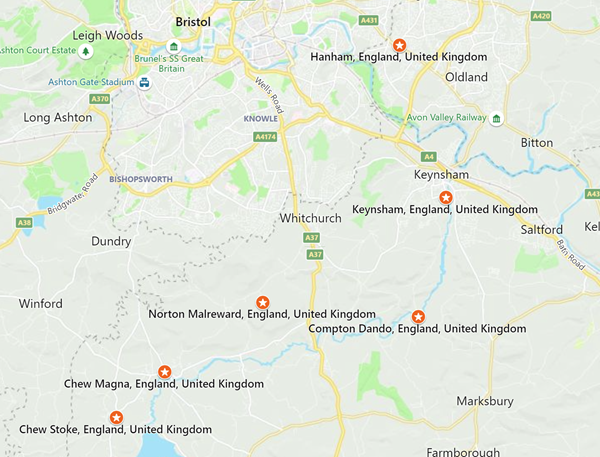Nurse Surname Origin
The primary goal in any family history research is to try and determine where the family originated. Sometimes, one is lucky and can accomplish this goal by pursuing the original records – birth/baptism, marriage, death/burial, wills and probate, but more often than not records are either lost or so illegible that the researcher reaches a dead end.

This happened to me when researching my Nurse lineage. I managed to trace the family origins with a high degree of confidence to the parish of Compton Dando (“Compton Dando” 2023) in northern Somerset, the first reference in that parish being the baptism of James Nurse, son of William and Sarah Nurse on 15th June 17351.
A thorough review of the parish records for the parishes of north Somerset (see Figure 2) showed that the family probably moved to Compton Dando from the area around Chew Magna (“Chew Magna” 2023) i.e. Chew Stoke,2 Chew Magna,3 and Norton Malreward4, to the south west of Compton Dando parish, and later I will show how I was able to push my Nurse ancestry back at least one more generation to that area.
There are a number of references to Nurse’s living in Chew Magna, the earliest reference in the parish being the burial of Joane Nurse of Stoke in 1573.
Joane Nurse of Stoke was buried on 19 Nov 1573.
At that time Chew Stoke was part of the parish of Chew Magna. However, due to the poor state of the original records as well as their incompleteness, these conclusions are quite tentative and my research into the Nurse line came to a grinding halt.

The next stage in determining a family’s origin is to carry out research on the origin of the surname, with the hope that it can be shown that the name must have originated from a single source. This is actually very rare, but in the case of Nurse we can develop a few possible scenarios.
So, what is the origin of the surname Nurse?
I will take two different approaches to this question.
- The first approach will be to study the etymology of the name, to determine if there is a unique source.
- The second approach will be a statistical geographical approach. Through the use of various records we can attempt to determine the geographic location of the surname.
There is a third approach that can be used to trace your paternal ancestry (which in effect is what tracing the history of your surname is) and that is to use DNA. This type of research is still in its infancy but can be used to confirm that male descendants with a common surname have a common Ancestor.
Bibliography
“Chew Magna.” 2023. Wikipedia; Wikimedia Foundation. 2023. https://en.wikipedia.org/w/index.php?title=Chew_Magna&oldid=1144250068.
“Compton Dando.” 2023. Wikipedia; Wikimedia Foundation. 2023. https://en.wikipedia.org/w/index.php?title=Compton_Dando&oldid=1153375694.
“Somerset, England, Church of England Baptisms, Marriages, and Burials, 1531-1812.” 2016. Ancestry.com. 2016. https://www.ancestry.co.uk/search/collections/60856/.
Footnotes
-
Parish Register for the Parish of St Mary, Compton Dando, Somerset (see “Somerset, England, Church of England Baptisms, Marriages, and Burials, 1531-1812” 2016).↩
-
Parish Register for the Parish of St Andrew, Chew Stoke, 1663-1812, Somerset (see “Somerset, England, Church of England Baptisms, Marriages, and Burials, 1531-1812” 2016).↩
-
Parish Register for the Parish of St Andrew, Chew Magna, 1560-1812, Somerset (see “Somerset, England, Church of England Baptisms, Marriages, and Burials, 1531-1812” 2016).↩
-
Parish Register for the Parish of Holy Trinity, Norton Malreward, 1554-1812, Somerset (see “Somerset, England, Church of England Baptisms, Marriages, and Burials, 1531-1812” 2016).↩